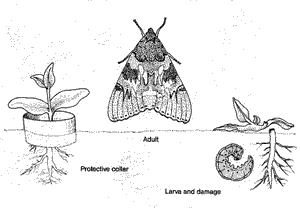 |
“Cutworm” is an general term for the larvae, or caterpillar stage, of more than 200 species of moths. Also called owlet moths or miller moths, these insects are serious pests of many crops and ornamental plants in all parts of the United States. Their larvae, cutworms, are many different colors--gray, brown, bronze, black, greenish-white or red--but all are fat, soft worms, with coarse bristles sparsely covering their bodies.
Cutworm larvae are different sizes as well, but most have grown to 1 or 2 inches long by the time they are interested in your plants. If you touch cutworms, they quickly roll up into a ball. You probably won't see them since they feed at night and hide in the soil during the day.
Cutworms develop into moths, sometimes known as “miller” or “owlet” moths. These rather plain, two-inch-wide grayish or brown moths hover around outdoor lights at night and may even wander indoors. Moths adults don't harm your plants because they feed solely on flower nectar. During the day they hide in debris and in other sheltered places.
In the fall, the females lay their white eggs near the soil, most frequently on weeds and grasses. During the growing season the moths lay eggs on crop plants soon after they have sprouted After the eggs hatch several weeks later, the tiny larvae burrow into the soil, emerging at night to feed on plant stems. Later they build small cells in the soil to pupate. They may spend 1 to 8 weeks in these cells, or even overwinter there, depending on the species. Some species may hatch up to 4 generations a year in warmer areas of the country.

